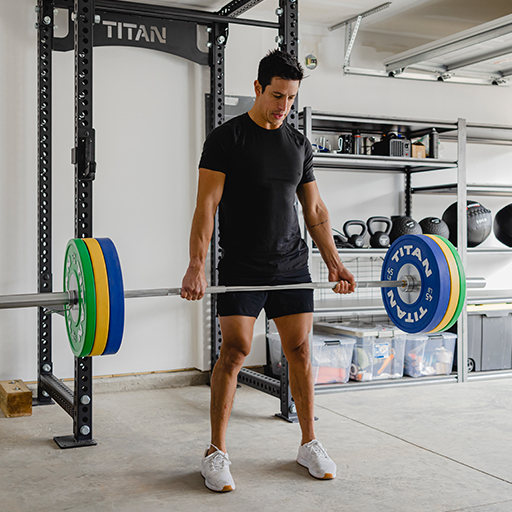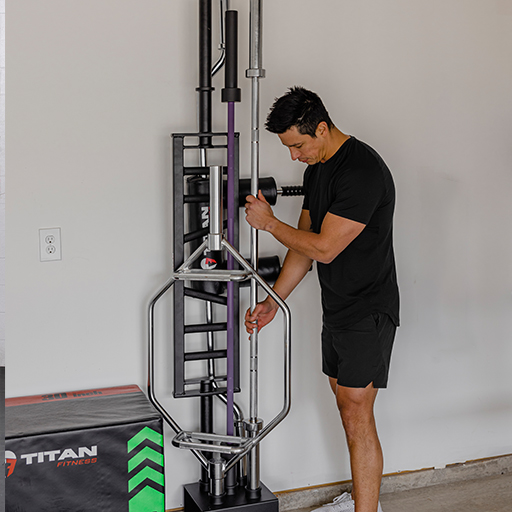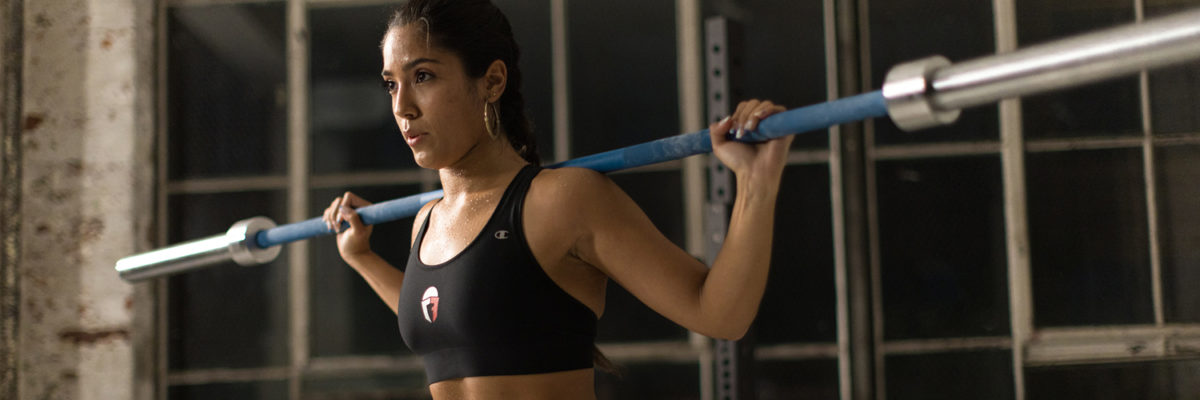Barbells might look like they’re all fundamentally made the same, but nothing could be further than the truth. Barbells differ considerably in size, materials, construction, weight capacity, and even shape. Whether brand new to weight training or a seasoned pro, these tips can help you choose the best barbell for your home gym.
Are Barbells the Best for Strength Training?
According to the American Council on Exercise (ACE), heavy resistance training is the most effective way to increase lean muscle and improve strength. And the experts agree: Barbells provide one of the best, most effective ways to pursue this type of training regimen. By mastering five of the most essential barbell routines — the bench press, squat, deadlift, overhead press, and lunge — you can get a great workout that will help you achieve your strength training and overall fitness goals.

Barbells vs. Dumbbells
Barbells and dumbbells can both accomplish many of the same goals in your workout routines. Barbells are much larger, heavier, longer, and more versatile. Dumbbells are small and compact and resemble a barbell in miniature, but with the weight plates permanently attached.
Barbells can be used for a wide range of Olympic-style weight training routines, including bench presses, deadlifts, overhead presses, and squats. They’re ideal for a variety of strength training programs because they allow you to work with heavier lifts as you progress. On the other hand, dumbbells are ideal for joint-isolation routines, such as shoulder raises and bicep curls, and are excellent for muscle building and different types of endurance training.
Each has its purpose, and ideally, a good home gym should have a selection of both barbells and dumbbells on hand.
Barbell Terms You Need to Know
If you’re shopping for a barbell, here are four barbell terms you’ll need to know:
Whip: “Whip” refers to how much a barbell will flex during a lift. A high whip means the barbell will have more flexibility during lifts, while a low whip means the barbell will remain rock-solid. If you’re doing heavy bench presses, you’ll want a low whip barbell for easier lifting as well as safety.
Knurling: The grip markings on a barbell are called “knurling.” The deeper the knurling, the more grip on the barbell.
Yield: The “yield” is how much weight the barbell can take before it permanently deforms and won’t go back to its original shape. You might also see this referred to as “yield strength.”
Spin: The “spin” indicates how much the sleeve on the shaft rotates. Certain movements, such as the clean and press, require more spin to protect your wrists.

What Makes a Great Barbell?
A great barbell should have enough tensile strength to accommodate heavyweight plates (or bumper plates) without bending, fracturing, or breaking. Depending on the type of barbell you want, a high-quality barbell should have the right level of whip, smooth rotating sleeves, and the right amount of knurling at optimum places for multi-grip ease and comfort. Ultimately, if you’re looking for a great barbell for your home gym, look for quality in construction. And speaking of construction…
What Are Barbells Made Of?
Barbells are made of different types of steel. The highest quality barbells are constructed of stainless steel, which provides greater yield strength while maintaining stability and straightness during repeated lifting. The outer layer of a barbell is coated with various materials, including black oxide, black zinc, and Cerakote. For example, Titan Fitness sells top-quality barbells that are coated in zinc and Cerakote for extra durability.
Types of Barbells
These are the basic types of barbells you’ll see on today’s fitness market:

Men’s Olympic Barbells
Olympic barbells are made from a variety of materials that gives them more whip. Titan Fitness’s Blues City Olympic Cerakote Barbells weigh around 45 pounds, with a diameter of 28.5mm, and have a weight capacity of 1,500 pounds.
Olympic weightlifting bars usually have fairly light knurling and are fitted with needle bearings that make them spin more easily to prevent arm and wrist injuries. Because they can accommodate a wide range of weights and fitness routines, Olympic weight barbells have more versatility than other types of barbells.
Women’s Olympic Barbells
So-called “women’s barbells” are simply Olympic barbells that are thinner, shorter in length, and lighter in weight than a standard barbell. Titan Fitness’s Women’s Bombshell Olympic Cerakote Barbells weigh 33 pounds and measure 25mm, with a shaft diameter of just under an inch and a weight capacity of 1,500 pounds. These barbells are ideal for serious lifters who are building up their strength and need a lighter barbell that’s easier to handle.
Powerlifting Barbells
Powerlifters generally concentrate on three kinds of lifts: bench presses, squats, and deadlifts. Titan Fitness’s Blues City Power Bars weigh around 45 pounds, measure 86.75 inches long, have a 28.5mm diameter, and have a weight capacity of 1,500 pounds. They’re designed to be more rigid, so they can accommodate the heavier weights required for powerlifting.
Quality powerlifting and Olympic bars usually hold up to 1,500 pounds. However, it’s important to be aware that, depending upon the quality of the barbell, some bars will start to bend when the weight reaches above 405 pounds.
In addition, you might also want to consider these types of barbells:
Hex or Trap Barbells
Hex bars (also known as trap bars) are made in the shape of a trapezoid. This unique shape enables you to position yourself in the center of gravity while doing deadlifts.
Deadlift Barbells
Deadlift bars have sharper knurling, plus more whip for better bar speed during lifting.
Specialty Barbells
In addition to the standard barbells listed above, you can also purchase specialty barbells, including:
Multigrip Barbells
Multigrip barbells provide multiple grips so you can vary your routine while reducing stress on your shoulders and wrists. As an example, these Angled Multigrip Barbells from Titan Fitness offer four grips set at varying lengths, allowing you to work different muscle groups from a variety of angles.
Safety Squat Barbells
Safety squat barbells are designed to safely enable you to add weight to your squats. For instance, the Safety Squat Olympic Bar from Titan Fitness has a bend on the weighted sleeves to help stabilize your center of gravity while the comfortable handgrips give you more control of the bar during the lift, boosting the security and safety of the exercise.
EZ Curl Barbells
EZ Curl barbells are amazingly versatile, with a twisted design that enables you to get a total body workout from your lifting routine. Titan Fitness offers a variety of EZ Curl Rubber Fixed Barbells that allow you to work with built-in weights so you can change up your lifts. And be sure to check out our huge selection of specialty bars, where you’ll find a wide range of angled, curl, Swiss, multigrip, and other bars to add more variety to your routine.
What to Consider When Buying a Barbell
Bar Diameter
Even the slightest variation in the bar diameter (or grip diameter) can determine how well a barbell will perform with specific routines. That’s why each type of barbell has a specific regulation diameter.
Strength
These two factors determine barbell strength:
- Tensile Strength
The tensile strength refers to the amount of weight a barbell can take before it fractures or breaks. Typically, a barbell’s tensile strength ranges from 120,000 to 230,000 pounds per square inch. The higher the tensile strength, the better the quality of the barbell.
- Yield Strength
The yield strength is the amount of weight it takes to bend the barbell permanently. Most of today’s barbell manufacturers list tensile strength rather than yield strength because tensile strength is considered the standard test of barbell strength.
Cost
Typically, barbells with higher tensile strength, such as Olympic bars, will cost more than standard barbells. However, Titan Fitness believes in providinge premium-quality equipment without the premium costs.
In addition, Titan Fitness offers free shipping on everything so your budget can go even further, plus a one-year warranty on all its equipment, so you can buy with confidence.

What Type of Barbell Should You Get?
As with many types of exercise equipment, barbells aren’t a one-size-fits-all proposition, and the type of barbell you get should depend on how you train.
Before choosing a barbell, it’s important to do your homework and learn about the different types available and how they can maximize your workout regimen. By talking to a fitness expert and considering your fitness and weight training goals, you should be able to choose a barbell that will optimize your strength training and boost your performance.
If you have any more questions about barbells or home gym equipment, we’ll be happy to help. Be sure to visit Titan Fitness to learn more about barbells, power racks, and everything you need to create an ideal workout space.


